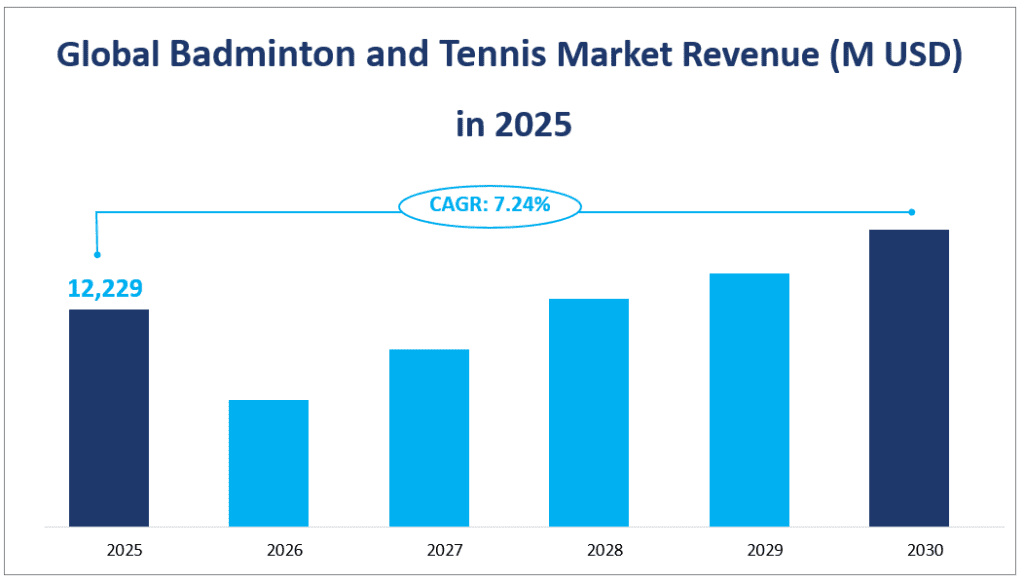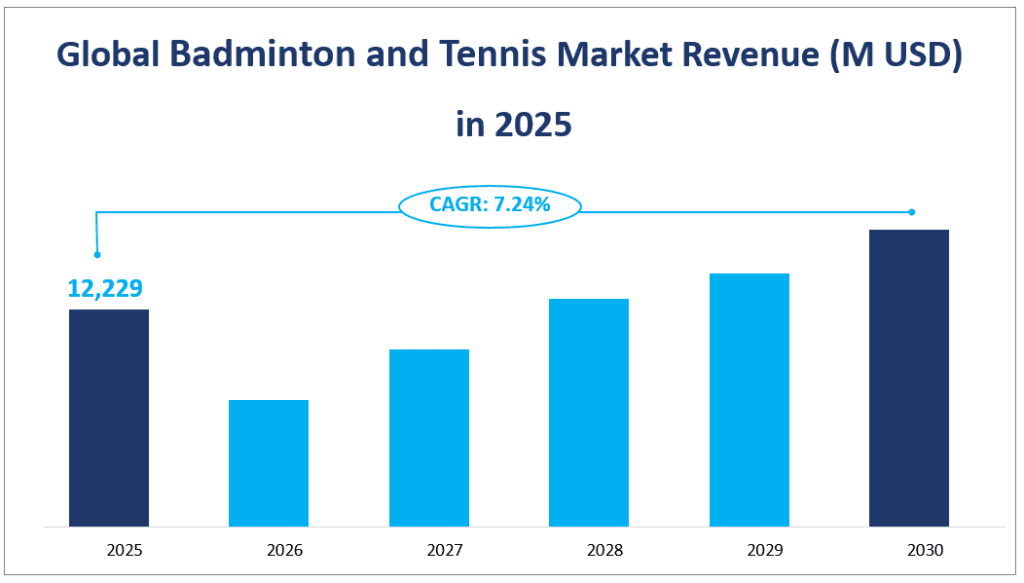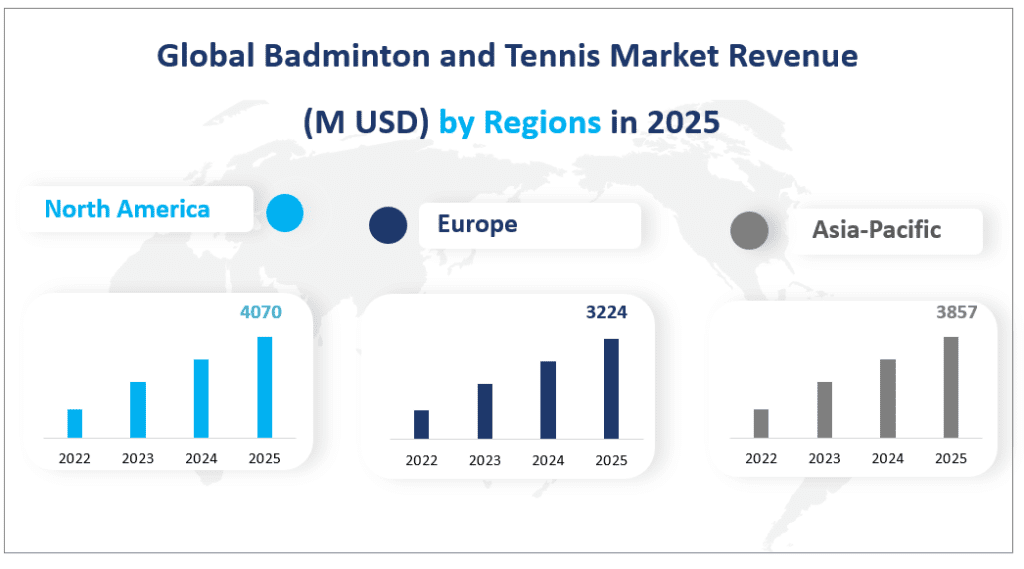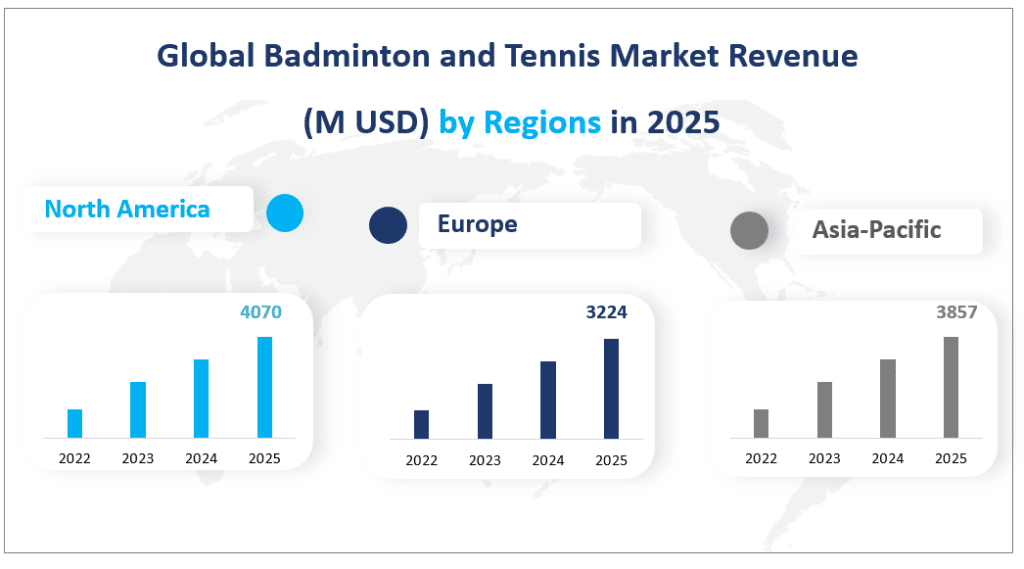1. Global Badminton and Tennis Market Definition
The global badminton and tennis market value will reach $12,229 million in 2025 with a CAGR of 7.24% from 2025 to 2030.
Badminton and tennis are two of the most popular racket sports globally, with a rich history and a growing number of enthusiasts. Badminton is a sport played using lightweight rackets to hit a shuttlecock across a net, often enjoyed in both casual settings and professional competitions. Tennis, on the other hand, is a game played individually or in doubles, using a hollow rubber ball covered with felt. Both sports require specialized equipment, including rackets, balls, strings, and apparel, which contribute significantly to the market value.
Global Badminton and Tennis Market Revenue (M USD) in 2025


2. Driving Factors of the Badminton and Tennis Market
Increasing Popularity of Sports: The rising awareness of the health benefits associated with badminton and tennis has led to a significant increase in participation rates. Both sports are known for their high-energy workouts and are particularly popular among the elderly population in developed economies. The growing number of badminton and tennis tournaments, such as the Super Series Badminton League and the Premier Badminton League, further fuels the market’s growth potential.
Celebrity Endorsements and Marketing: Many brands leverage celebrity endorsements to enhance their market presence. For instance, Puma’s collaboration with Rihanna as its brand creative director has significantly boosted its sales. Such strategies increase brand awareness and consumer trust, driving demand for badminton and tennis products.
Technological Advancements: The use of high-end manufacturing technologies and advanced materials is becoming more prevalent in the production of badminton and tennis equipment. This trend is expected to result in a continuous influx of new products with upgraded attributes, attracting both professional players and casual enthusiasts.
E-commerce Boom: The rise of online retail platforms has revolutionized the way consumers purchase sports equipment. The convenience of online shopping, coupled with the availability of extensive product information and reviews, has led to a significant increase in the sale of badminton and tennis products through digital channels. This trend is expected to continue, further boosting market growth.
3. Limiting Factors of the Badminton and Tennis Market
Intense Competition: The badminton and tennis market is highly fragmented, with a large number of manufacturers competing globally. This intense competition often leads to reduced profit margins as companies lower their prices to attract price-sensitive customers. The presence of numerous small-scale players also results in the proliferation of sub-standard products, which can harm the market’s overall reputation.
Casual Consumer Behavior: Many amateur badminton and tennis players prefer to use casual sportswear instead of specialized apparel and footwear. This behavior reduces the demand for professional badminton and tennis attire, limiting the market’s potential growth. The casual nature of amateur participation also means that consumers may not prioritize investing in high-quality equipment, further impacting sales.
4. Badminton and Tennis Market Segment
Product Types
In 2025, the Hard Goods segment is expected to achieve a market value of $2,362 million, while the Soft Goods segment is projected to reach $9966 million. This indicates that Soft Goods will continue to dominate the market in terms of value.
Among the Hard Goods, Badminton Racquets are projected to have the highest market value at $999 million, followed by Tennis Balls at $329 million. These figures highlight the significant demand for high-quality equipment, especially in regions where badminton is highly popular.
When analyzing growth rates, Soft Goods are expected to exhibit a slightly higher CAGR compared to Hard Goods. Specifically, the Badminton Apparel segment is anticipated to grow at the fastest rate within the Soft Goods category, driven by increasing participation in badminton tournaments and the rising demand for specialized attire. By 2025, Badminton Apparel is projected to reach $2,6337 million, reflecting a robust growth trajectory.
In summary, while Soft Goods dominate the market in terms of value, Hard Goods, particularly Badminton Shuttlecocks, are poised for significant growth. This trend underscores the dynamic nature of the badminton and tennis market, driven by both casual participation and professional competition.
Different Applications
By 2025, the Amateur Field application is projected to achieve a market value of $9382 million in 2025. This segment includes casual players and enthusiasts who participate in badminton and tennis for recreational purposes. The significant market share of the Amateur Field underscores the widespread popularity of these sports among the general population.
In contrast, the Professional Field application is expected to reach $2847 million by 2025. This segment includes professional players, tournaments, and high-performance training facilities. While it represents a smaller portion of the market, the Professional Field is characterized by higher demand for premium-quality equipment and specialized apparel.
When examining growth rates, the Amateur Field is expected to exhibit a slightly higher CAGR compared to the Professional Field. This trend is driven by the increasing number of badminton and tennis leagues organized at regional, national, and district levels. The rising popularity of these sports as recreational activities is also contributing to the growth of the Amateur Field.
Market Value by Segment
| Market Value (M USD) in 2025 | ||
| By Type | Hard goods | 2263 |
| Soft goods | 9966 | |
| By Application | Amateur Field | 9382 |
| Professional Field | 2847 |
5. Regional Badminton and Tennis Market
North America is projected to be the largest badminton and tennis market by value, with a projected market value of $4070 million in 2025. The United States, in particular, drives the region’s market, supported by a strong sports economy, high consumer spending power, and a growing interest in fitness and recreational activities.
By 2025, the Asia-Pacific region is also a significant player, reaching $3857 million. This region’s dominance is driven by the widespread popularity of badminton and tennis, particularly in countries like China, India, and Indonesia. The region’s robust economic growth, increasing disposable incomes, and expanding middle class further fuel the demand for high-quality sports equipment and apparel.
Following closely is Europe, with a market value of $3224 million in2025. Europe’s badminton and tennis market strength is attributed to its rich sporting culture, well-established sports infrastructure, and high participation rates in racket sports. Countries like Germany, the UK, and France are key contributors to the region’s market value.
The Middle East and Africa are expected to be the fastest-growing regions, driven by increasing investments in sports infrastructure, growing participation in racket sports, and rising disposable incomes. The region’s growth is further supported by government initiatives to promote sports and physical activities as part of public health programs. In conclusion, the global badminton and tennis market is expected to witness significant growth by 2025, with the Asia-Pacific region leading in terms of market value. However, the Middle East and Africa are poised to be the fastest-growing regions, driven by increasing investments and rising consumer demand. Stakeholders must focus on these regional dynamics to capitalize on emerging opportunities and drive sustainable growth.
Global Badminton and Tennis Market Revenue (M USD) by Regions in 2025


6. Top 3 Companies in the Badminton and Tennis Market
Company Introduction and Business Overview:
Nike, Inc. is a leading global sports apparel and equipment manufacturer, founded in 1964 and headquartered in Beaverton, Oregon, USA. Nike designs, develops, and markets athletic footwear, apparel, equipment, and accessories for various sports, including badminton and tennis. The company is renowned for its innovative products and strong brand presence worldwide.
Products Offered:
Nike offers a comprehensive range of badminton and tennis products, including high-performance shoes, apparel, and equipment. Key products include the NikeCourt Zoom Vapor X Air Max 95 tennis shoes, designed for superior cushioning and traction, and various badminton shoes and apparel tailored for professional and amateur players.
Company Introduction and Business Overview:
Adidas AG, founded in 1949 and headquartered in Herzogenaurach, Germany, is a global leader in sports apparel and equipment. The company offers a wide range of products for various sports, including badminton and tennis. Adidas is known for its commitment to innovation, sustainability, and high-quality products.
Products Offered:
Adidas provides a diverse range of badminton and tennis products, including the Defiant Generation Multicourt Tennis Shoes, designed for superior comfort and performance. The company also offers a variety of badminton shoes, apparel, and equipment tailored for both professional and amateur players.
Company Introduction and Business Overview:
Yonex Co., Ltd., founded in 1946 and headquartered in Tokyo, Japan, is a leading manufacturer of sports equipment. Yonex specializes in producing high-quality equipment for badminton, tennis, golf, and running. The company is renowned for its innovative technologies and premium products.
Products Offered:
Yonex offers a wide range of badminton and tennis products, including the ASTROX 100ZZ badminton racquet, designed for advanced players seeking high performance. The company also provides various tennis racquets, shoes, apparel, and accessories tailored for professional and amateur players.
Major Players
| Company Name | Headquarter | Sales Region |
| Nike | Beaverton, OR, USA | Worldwide |
| Adidas | Herzogenaurach, Germany | Worldwide |
| Yonex | Tokyo, Japan | Worldwide |
| Victor | Taipei, Taiwan | Worldwide |
| Li-Ning | Beijing, China | Worldwide |
| Babolat | Lyon, France | Worldwide |
| Wilson | Chicago, IL, USA | Worldwide |
| Head | Phoenix, AZ, USA | Worldwide |
| Prince | Atlanta, GA, USA | Worldwide |
| Dunlop | London, UK | Worldwide |
| VOLKL | Munich, Germany | Worldwide |
| Tecnifibre | Feucherolles, France | Worldwide |
| DHS | Shanghai, China | Worldwide |
| KAWASAKI | Tallinn, Estonia | Worldwide |
| Teloon | Wenzhou, Zhejiang, China | Worldwide |
| OLIVER | Glasgow, Scotland, UK | Worldwide |
1 Badminton and Tennis Introduction and Market Overview
1.1 Objectives of the Study
1.2 Overview of Badminton and Tennis
1.3 Scope of The Study
1.3.1 Key Market Segments
1.3.2 Players Covered
1.3.3 COVID-19’s impact on the Badminton and Tennis industry
1.4 Methodology of The Study
1.5 Research Data Source
1.5.1 Secondary Data
1.5.2 Primary Data
1.5.3 Market Size Estimation
1.5.4 Legal Disclaimer
2 Executive Summary
2.1 Market Overview
2.1.1 Global Badminton and Tennis Market Size, 2016-2021
2.1.2 Global Badminton and Tennis Market Size by Type, 2016-2021
2.1.3 Global Badminton and Tennis Market Size by Application, 2016-2021
2.1.4 Global Badminton and Tennis Market Size by Region, 2016-2021
2.2 Business Environment Analysis
2.2.1 Global COVID-19 Status and Economic Overview
2.2.2 Influence of COVID-19 Outbreak on Badminton and Tennis Industry Development
2.3 Global Padel Sports Market Size and Growth Rate
2.4 Major Wholesaler
2.5 USA Pickleball Market Size and Growth Rate
3 Industry Chain Analysis
3.1 Upstream Raw Material Suppliers of Badminton and Tennis Analysis
3.2 Badminton and Tennis Manufacturing Cost Structure Analysis
3.2.1 Production Process Analysis
3.2.2 Manufacturing Cost Structure of Badminton and Tennis
3.2.3 Labor Cost of Badminton and Tennis
3.3 Market Distributors of Badminton and Tennis
3.4 Major Downstream Buyers of Badminton and Tennis Analysis
3.5 The Impact of Covid-19 From the Perspective of Industry Chain
4 Global Badminton and Tennis Market, by Type
4.1 Global Badminton and Tennis Value and Market Share by Type (2016-2021)
4.2 Global Badminton and Tennis Consumption and Market Share by Type (2016-2021)
4.3 Global Badminton and Tennis Value and Growth Rate by Type (2016-2021)
4.3.1 Global Badminton and Tennis Value and Growth Rate of Hard goods (2016-2021)
4.3.2 Global Badminton and Tennis Value and Growth Rate of Soft goods (2016-2021)
4.4 Global Badminton and Tennis Price Analysis by Type (2016-2021)
5 Badminton and Tennis Market, by Application
5.1 Downstream Market Overview
5.2 Global Badminton and Tennis Consumption and Market Share by Application (2016-2021)
5.3 Global Badminton and Tennis Consumption and Growth Rate by Application (2016-2021)
5.3.1 Global Badminton and Tennis Consumption and Growth Rate of Amateur Field (2016-2021)
5.3.2 Global Badminton and Tennis Consumption and Growth Rate of Professional Field (2016-2021)
6 Global Badminton and Tennis Market Analysis by Regions
6.1 Global Badminton and Tennis Sales, Value and Market Share by Regions
6.1.1 Global Badminton and Tennis Sales by Regions (2016-2021)
6.1.2 Global Badminton and Tennis Value by Regions (2016-2021)
6.2 North America Badminton and Tennis Sales and Growth Rate (2016-2021)
6.3 Europe Badminton and Tennis Sales and Growth Rate (2016-2021)
6.4 Asia-Pacific Badminton and Tennis Sales and Growth Rate (2016-2021)
6.5 Middle East and Africa Badminton and Tennis Sales and Growth Rate (2016-2021)
6.6 South America Badminton and Tennis Sales and Growth Rate (2016-2021)
7 North America Badminton and Tennis Market Analysis by Countries
7.1 The Influence of COVID-19 on North America Market
7.2 North America Badminton and Tennis Sales, Value and Market Share by Countries
7.2.1 North America Badminton and Tennis Sales by Countries (2016-2021)
7.2.2 North America Badminton and Tennis Value by Countries (2016-2021)
7.3 United States Badminton and Tennis Sales and Growth Rate (2016-2021)
7.4 Canada Badminton and Tennis Sales and Growth Rate (2016-2021)
7.5 Mexico Badminton and Tennis Sales and Growth Rate (2016-2021)
8 Europe Badminton and Tennis Market Analysis by Countries
8.1 The Influence of COVID-19 on Europe Market
8.2 Europe Badminton and Tennis Sales, Value and Market Share by Countries
8.2.1 Europe Badminton and Tennis Sales by Countries (2016-2021)
8.2.2 Europe Badminton and Tennis Value by Countries (2016-2021)
8.3 Germany Badminton and Tennis Sales and Growth Rate (2016-2021)
8.4 UK Badminton and Tennis Sales and Growth Rate (2016-2021)
8.5 France Badminton and Tennis Sales and Growth Rate (2016-2021)
8.6 Italy Badminton and Tennis Sales and Growth Rate (2016-2021)
8.7 Spain Badminton and Tennis Sales and Growth Rate (2016-2021)
8.8 Russia Badminton and Tennis Sales and Growth Rate (2016-2021)
9 Asia Pacific Badminton and Tennis Market Analysis by Countries
9.1 The Influence of COVID-19 on Asia Pacific Market
9.2 Asia Pacific Badminton and Tennis Sales, Value and Market Share by Countries
9.2.1 Asia Pacific Badminton and Tennis Sales by Countries (2016-2021)
9.2.2 Asia Pacific Badminton and Tennis Value by Countries (2016-2021)
9.3 China Badminton and Tennis Sales and Growth Rate (2016-2021)
9.4 Japan Badminton and Tennis Sales and Growth Rate (2016-2021)
9.5 South Korea Badminton and Tennis Sales and Growth Rate (2016-2021)
9.6 India Badminton and Tennis Sales and Growth Rate (2016-2021)
9.7 Southeast Asia Badminton and Tennis Sales and Growth Rate (2016-2021)
9.8 Australia Badminton and Tennis Sales and Growth Rate (2016-2021)
10 Middle East and Africa Badminton and Tennis Market Analysis by Countries
10.1 The Influence of COVID-19 on Middle East and Africa Market
10.2 Middle East and Africa Badminton and Tennis Sales, Value and Market Share by Countries
10.2.1 Middle East and Africa Badminton and Tennis Sales by Countries (2016-2021)
10.2.2 Middle East and Africa Badminton and Tennis Value by Countries (2016-2021)
10.3 Saudi Arabia Badminton and Tennis Sales and Growth Rate (2016-2021)
10.4 UAE Badminton and Tennis Sales and Growth Rate (2016-2021)
10.5 Egypt Badminton and Tennis Sales and Growth Rate (2016-2021)
10.6 Nigeria Badminton and Tennis Sales and Growth Rate (2016-2021)
10.7 South Africa Badminton and Tennis Sales and Growth Rate (2016-2021)
11 South America Badminton and Tennis Market Analysis by Countries
11.1 The Influence of COVID-19 on South America Market
11.2 South America Badminton and Tennis Sales, Value and Market Share by Countries
11.2.1 South America Badminton and Tennis Sales by Countries (2016-2021)
11.2.2 South America Badminton and Tennis Value by Countries (2016-2021)
11.3 Brazil Badminton and Tennis Sales and Growth Rate (2016-2021)
11.4 Argentina Badminton and Tennis Sales and Growth Rate (2016-2021)
11.5 Colombia Badminton and Tennis Sales and Growth Rate (2016-2021)
11.6 Chile Badminton and Tennis Sales and Growth Rate (2016-2021)
12 Competitive Landscape
12.1 Competitive Landscape Changes Caused by COVID-19 Outbreak
12.2 Nike
12.2.1 Company Profiles
12.2.2 Badminton and Tennis Product Introduction
12.2.3 Nike Sales, Value, Price, Gross Margin 2016-2021
12.3 Adidas
12.3.1 Company Profiles
12.3.2 Badminton and Tennis Product Introduction
12.3.3 Adidas Sales, Value, Price, Gross Margin 2016-2021
12.4 Yonex
12.4.1 Company Profiles
12.4.2 Badminton and Tennis Product Introduction
12.4.3 Yonex Sales, Value, Price, Gross Margin 2016-2021
12.5 Victor
12.5.1 Company Profiles
12.5.2 Badminton and Tennis Product Introduction
12.5.3 Victor Sales, Value, Price, Gross Margin 2016-2021
12.6 Li-Ning
12.6.1 Company Profiles
12.6.2 Badminton and Tennis Product Introduction
12.6.3 Li-Ning Sales, Value, Price, Gross Margin 2016-2021
12.7 Babolat
12.7.1 Company Profiles
12.7.2 Badminton and Tennis Product Introduction
12.7.3 Babolat Sales, Value, Price, Gross Margin 2016-2021
12.8 Wilson
12.8.1 Company Profiles
12.8.2 Badminton and Tennis Product Introduction
12.8.3 Wilson Sales, Value, Price, Gross Margin 2016-2021
12.9 Head
12.9.1 Company Profiles
12.9.2 Badminton and Tennis Product Introduction
12.9.3 Head Sales, Value, Price, Gross Margin 2016-2021
12.10 Prince
12.10.1 Company Profiles
12.10.2 Badminton and Tennis Product Introduction
12.10.3 Prince Sales, Value, Price, Gross Margin 2016-2021
12.11 Dunlop
12.11.1 Company Profiles
12.11.2 Badminton and Tennis Product Introduction
12.11.3 Dunlop Sales, Value, Price, Gross Margin 2016-2021
12.12 VOLKL
12.12.1 Company Profiles
12.12.2 Badminton and Tennis Product Introduction
12.12.3 VOLKL Sales, Value, Price, Gross Margin 2016-2021
12.13 Tecnifibre
12.13.1 Company Profiles
12.13.2 Badminton and Tennis Product Introduction
12.13.3 Tecnifibre Sales, Value, Price, Gross Margin 2016-2021
12.14 DHS
12.14.1 Company Profiles
12.14.2 Badminton and Tennis Product Introduction
12.14.3 DHS Sales, Value, Price, Gross Margin 2016-2021
12.15 KAWASAKI
12.15.1 Company Profiles
12.15.2 Badminton and Tennis Product Introduction
12.15.3 KAWASAKI Sales, Value, Price, Gross Margin 2016-2021
12.16 Teloon
12.16.1 Company Profiles
12.16.2 Badminton and Tennis Product Introduction
12.16.3 Teloon Sales, Value, Price, Gross Margin 2016-2021
12.17 OLIVER
12.17.1 Company Profiles
12.17.2 Badminton and Tennis Product Introduction
12.17.3 OLIVER Sales, Value, Price, Gross Margin 2016-2021
13 Industry Outlook
13.1 Market Driver Analysis
13.1.1 Market Restraints Analysis
13.1.2 Market Trends Analysis
13.2 Merger, Acquisition and New Investment
13.3 News of Product Release
14 Global Badminton and Tennis Market Forecast
14.1 Global Badminton and Tennis Market Value & Volume Forecast, by Type (2021-2026)
14.1.1 Hard goods Market Value and Volume Forecast (2021-2026)
14.1.2 Soft goods Market Value and Volume Forecast (2021-2026)
14.2 Global Badminton and Tennis Market Value & Volume Forecast, by Application (2021-2026)
14.2.1 Amateur Field Market Value and Volume Forecast (2021-2026)
14.2.2 Professional Field Market Value and Volume Forecast (2021-2026)
14.3 Badminton and Tennis Market Analysis and Forecast by Region
14.3.1 North America Market Value and Consumption Forecast (2021-2026)
14.3.2 Europe Market Value and Consumption Forecast (2021-2026)
14.3.3 Asia Pacific Market Value and Consumption Forecast (2021-2026)
14.3.4 Middle East and Africa Market Value and Consumption Forecast (2021-2026)
14.3.5 South America Market Value and Consumption Forecast (2021-2026)
15 New Project Feasibility Analysis
15.1 Industry Barriers and New Entrants SWOT Analysis
15.1.1 Porter’s Five Forces Analysis
15.1.2 New Entrants SWOT Analysis
15.2 Analysis and Suggestions on New Project Investment
